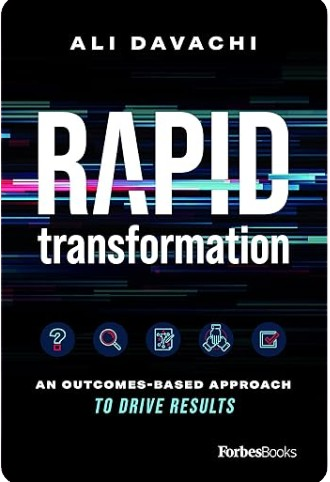RAPID Transformation: A Strategic Approach to Digital Success
Developed by Ali Davachi, this framework provides a systematic approach to integrating technology, refining business processes, and enhancing decision-making. By aligning innovation with strategy, RAPID enables businesses to adapt, scale, and succeed in an evolving digital landscape.
What is the RAPID Framework?
Drawing on over 25 years of experience with both Fortune 500 companies and startups, Davachi introduces this approach in his book, "RAPID Transformation: An Outcomes-Based Approach to Drive Results." This framework ensures that cutting-edge technology aligns with an organization's unique strengths, enabling businesses to enhance efficiency, improve decision-making, and adapt to market changes effectively.

The Five Phases of RAPID Transformation
The RAPID Transformation Framework, developed by Ali Davachi, is a structured, outcomes-based methodology designed to streamline digital transformation and drive measurable business results.
Research
Successful transformation starts with a deep understanding of an organization's current state, challenges, and opportunities.
This phase involves:
- Conducting market research and internal assessments.
- Engaging stakeholders, employees, and customers for valuable insights.
- Gathering data-driven evidence to inform strategic decisions.
Analyze
Once data is collected, it must be carefully examined to identify patterns, inefficiencies, and opportunities for improvement.
This phase includes:
- Evaluating root causes of business challenges.
- Uncovering market trends, operational bottlenecks, and customer pain points.
- Developing data-backed insights to drive informed decision-making.
Plan
A well-structured plan ensures a clear roadmap for transformation.
This phase focuses on:
- Defining key objectives, milestones, and resource allocation.
- Establishing performance metrics (KPIs) to measure success.
- Aligning the strategy with organizational goals and customer expectations.
Implement
Execution is key to transformation. In this phase, teams work together to deploy solutions, integrate technology, and refine workflows while maintaining flexibility.
It involves:
- Coordinating cross-functional teams for seamless execution.
- Deploying AI, automation, cloud solutions, and other enabling technologies.
- Ensuring continuous feedback loops to adapt to challenges in real time.
Decide
Transformation is an ongoing process. The final phase ensures that measured results inform future strategy.
This includes:
- Evaluating outcomes against established KPIs.
- Adjusting processes, strategies, or technology implementations as needed.
- Maintaining continuous improvement for long-term success.
Comprehensive Business Strategy & Technology Planning
Success in today's business environment requires a strategy that bridges operational needs with technological advancements. Learn how to bridge that gap with our experts today.
Key Principles of the RAPID Framework
Human-Centered Approach
A successful digital transformation strategy must prioritize people—customers, employees, and stakeholders. The RAPID framework fosters collaboration, enhances user experiences, and ensures alignment with human needs.
Data-Driven Decision Making
Instead of relying on intuition, RAPID transformation is built on empirical data. Every decision is backed by real-time analytics, predictive modeling, and performance metrics, ensuring measurable impact.
Adaptability & Agility
Markets and technology evolve rapidly. The RAPID methodology encourages organizations to remain flexible, iterate quickly, and embrace continuous innovation, enabling them to stay ahead of competitors.
APPLICATIONS & BENEFITS OF RAPID TRANSFORMATION
The RAPID framework is versatile and scalable, making it ideal for organizations across technology, healthcare, finance, retail, and beyond. Companies that adopt this framework experience:
STRONGER ALIGNMENT BETWEEN TECHNOLOGY AND BUSINESS STRATEGY
FASTER DECISION-MAKING THROUGH REAL-TIME DATA ANALYSIS
OPTIMIZED OPERATIONAL EFFICIENCY AND REDUCED COSTS
IMPROVED CUSTOMER EXPERIENCES AND ENGAGEMENT
SUSTAINABLE GROWTH THROUGH CONTINUOUS PROCESS IMPROVEMENT
WHY RAPID MATTERS FOR DIGITAL TRANSFORMATION
As businesses face increasing complexity and digital disruption, a structured approach to transformation is critical. The RAPID framework provides a clear, actionable roadmap to help organizations adopt new technologies, optimize processes, and drive meaningful change—ensuring long-term success in a competitive market.